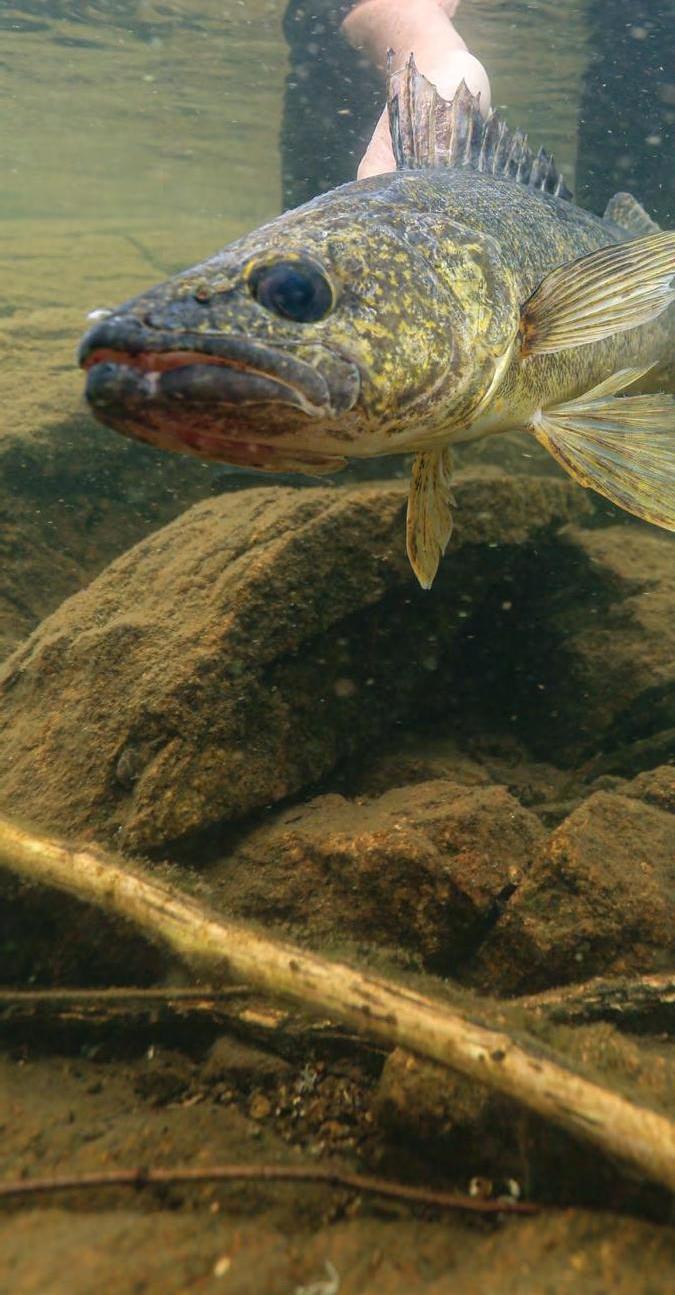
4 minute read
Not Taken For GRANTED
Exploring and Solving Problems with Funded Fish Research
► by Mary McIntyre
Each year, Alberta Conservation Association’s Research Grants fund high quality research projects on wildlife, fish and habitat which inform the effective management of wildlife, fish populations, and habitat in Alberta. The following three studies are examples of research that has been completed with a focus on Alberta fish.

photo: ACA, Brad Downey
Testing anglers’ BELIEFS with DATA
“If we don’t reduce walleye numbers, won’t they stunt growth or create an ecological imbalance?”
This question was repeatedly brought forward at Government of Alberta fisheries management open house events. Fisheries officials were gathering feedback from anglers on current management practices throughout the province. This took place under the direction of Alberta Environment and Parks Minister, Jason Nixon, between January and February 2020.
Many anglers voiced a belief that small or skinny walleye was evidence for the fish being slow-growing or stunted, presumably because of an oversupply of fish, which then eat themselves out of house and home.
An Alberta researcher and graduate student also attended many of the events, but for different reasons. They volunteered their time at these gatherings to listen and talk to anglers so they could better understand the issues anglers face.
These conversations lead Dr. John R. Post, professor at the University of Calgary (U of C), and Christopher Cahill, PhD candidate, also at the U of C, to investigate if the size of a walleye population influenced its growth rate. “They had good reason to be concerned about it. This phenomenon occurs regularly in fish populations around the world,” said Cahill.
Post and Cahill spent two years combing through Alberta data to determine if this phenomenon was occurring in Alberta's walleye lakes, assessing nearly 40,000 walleye from over 100 lakes, and spanning 20 years in the process.
Using state-of-the-art spatial-temporal statistics, they found that walleye growth rates did not decrease from 2000 to 2018. Follow-up research in 2019/20 led them to their key finding: walleye population size did not appear to influence fish growth rates. Cahill noted that this new information does not mean anglers are wrong: “It is possible that something else might be responsible for anglers' observations.”
So, keep on sharing those observations, Alberta anglers! And for more fish research, check out Dr. Post’s research at John R. Post Fisheries Lab, U of C, at www.jrpostfisherieslab.wixsite.com/postlab.

photo: USFWS, Andrew Gilham
Using environmental DNA to detect Arctic grayling
Arctic grayling are listed as a Species of Special Concern in Alberta’s Wildlife Act due to increasing environmental stressors like changes in water temperature, salinity, contaminants, and habitat fragmentation.
To improve conservation efforts, we need a better understanding of the locations of Arctic grayling populations, their migration pathways at different life stages, and their preferred habitats. Monitoring their populations has proved problematic due to their migratory nature, low densities, and limited capacity for capture with standard fishing methods. To get answers, University of Alberta post-doctoral fellow, Dr. Heather
Veilleux, and undergraduate researcher, Melissa Misutka, have established an important method to detect sensitive and specific environmental DNA for this fish that’s native to northern Alberta. The team has been working under the supervision of Dr. Chris Glover, a professor at Athabasca University and a Campus Alberta Innovation Program research chair.
This research offers an important advancement in the monitoring and management of Arctic grayling populations. Data collected and yearly testing can tell us how populations are affected by changes to habitat, angling practices, or climate, and can inform population management decisions that help Arctic grayling persist in Alberta’s waters.
Minnows: The early warning system of aquatic ecosystems
Have you ever seen children walking along a shoreline point to a group of small fish they see in the water and hear them say, "Look at the minnows?"
Little minnows are big players in the aquatic community because they are a food source for many larger predatory fishes. Alberta is home to one species of minnow that cannot be found anywhere else in Canada. Western silvery minnows only live in parts of the southern sections of the Milk River. They are listed in Alberta’s recovery plan as having only small scattered populations.
A global, dramatic loss of fish biodiversity has made aquatic ecosystems more susceptible to other natural and human disturbances. Dr. Mark Poesch, associate professor and lead of the Fisheries and Aquatic Conservation Lab at the University of Alberta, set out to increase our understanding of spawning habitat and reproductive behaviour of western silvery minnows.
He was the first to document this minnows’ broad habitat use. Dr. Poesch learned that this minnow is vulnerable to extreme climatic fluctuations and highly variable water levels. These results will provide fisheries managers the ability to recover important habitat types and develop appropriate monitoring strategies for the Western silvery minnow. It is currently listed as Threatened under Alberta’s Wildlife Act.
For more information about ACA’s Grants Program, please visit www.ab-conservation.com/grants/aca-grant-programs
cover photo: Ryan Witteman










